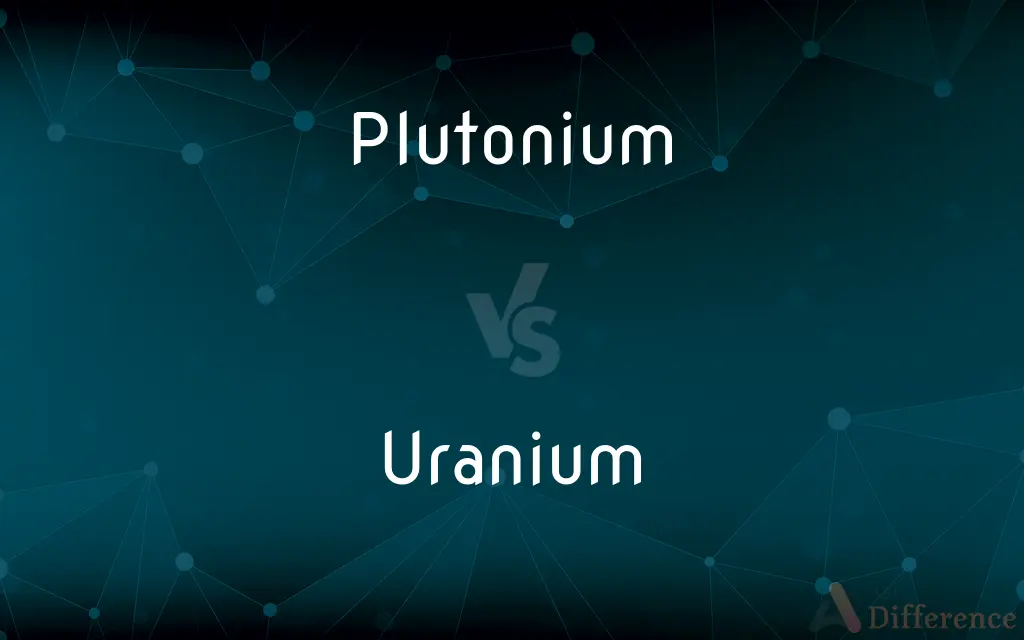Plutonium vs. Uranium — What's the Difference?
Edited by Tayyaba Rehman — By Urooj Arif — Updated on April 8, 2024
Plutonium is denser and more radioactive than uranium, which is more abundant and serves as a primary fuel in nuclear reactors.

Difference Between Plutonium and Uranium
Table of Contents
ADVERTISEMENT
Key Differences
Plutonium and uranium are both radioactive elements, but they have distinct characteristics and applications. Plutonium, with the atomic number 94, is a heavy, silvery metal that is primarily used in nuclear weapons and as a fuel in some types of nuclear reactors. It is produced by bombarding uranium-238 with neutrons in a reactor. Uranium, on the other hand, has the atomic number 92 and is a dense, weakly radioactive metal. It occurs naturally in low concentrations in soil, rock, and water, and is commercially extracted from uranium-bearing minerals. The most common isotopes are uranium-235 and uranium-238.
Plutonium is highly radioactive and can be dangerous if not handled properly. It has several isotopes, with plutonium-239 being the most significant for nuclear fission reactions. Uranium-235 is rare but crucial for nuclear reactors and weapons because it is fissile, meaning it can sustain a nuclear chain reaction. Uranium-238, which makes up the majority of natural uranium, is fertile, not fissile, and can be converted into plutonium-239 in breeder reactors.
While plutonium is primarily man-made and sourced from reprocessing spent nuclear fuel, uranium is mined from the Earth. This makes uranium more accessible and widely used as fuel for nuclear power plants. Plutonium's application is more specialized, often focused on advanced nuclear reactors and nuclear weapons due to its high radioactivity and ability to undergo fission with both fast and slow neutrons.
Both elements are critical to the field of nuclear energy and weapons development. However, their use and handling require stringent safety measures due to their radioactive nature and the potential for nuclear proliferation. The choice between using plutonium or uranium in a nuclear reactor depends on the reactor design, desired outcomes, and available resources.
Comparison Chart
Atomic Number
94
92
ADVERTISEMENT
Natural Occurrence
Almost none; primarily man-made
Naturally occurring in small quantities
Main Use
Nuclear weapons, some nuclear reactors
Fuel for nuclear power plants, nuclear weapons
Key Isotopes
Plutonium-239
Uranium-235, Uranium-238
Radioactivity
Highly radioactive; requires careful handling
Weakly radioactive compared to plutonium
Compare with Definitions
Plutonium
Plutonium is a man-made element created in nuclear reactors.
Plutonium-239 is used in nuclear weapons.
Uranium
Uranium is the heaviest naturally occurring element on Earth.
It's widely used as fuel in nuclear reactors.
Plutonium
Plutonium has no stable isotopes and primarily exists due to human activities.
It's produced by bombarding uranium-238.
Uranium
Uranium serves as the starting material for other radioactive elements.
Bombarding U-238 creates plutonium-239.
Plutonium
Plutonium is used in fast breeder reactors to generate more fuel.
It enables the production of more plutonium-239.
Uranium
Uranium has two primary isotopes: uranium-235 and uranium-238.
Uranium-235 is key for nuclear fission.
Plutonium
Plutonium is more toxic and poses a greater risk of radiation poisoning.
Inhalation of plutonium dust can be lethal.
Uranium
Uranium is less toxic than plutonium but still requires careful handling.
It's stored in secure facilities to prevent contamination.
Plutonium
Plutonium is denser and more radioactive than uranium.
It is handled with strict safety protocols.
Uranium
Uranium is extracted from the Earth through mining.
Kazakhstan, Canada, and Australia are top producers.
Plutonium
Plutonium is a radioactive chemical element with the symbol Pu and atomic number 94. It is an actinide metal of silvery-gray appearance that tarnishes when exposed to air, and forms a dull coating when oxidized.
Uranium
Uranium is a chemical element with the symbol U and atomic number 92. It is a silvery-grey metal in the actinide series of the periodic table.
Plutonium
A radioactive, silvery, metallic transuranic element, occurring in uranium ores and produced artificially by neutron bombardment of uranium. Its longest-lived isotope is Pu-244 with a half-life of 80 million years. It is a radiological poison, specifically absorbed by bone marrow, and is used, especially the highly fissionable isotope Pu-239, as a reactor fuel and in nuclear weapons. Atomic number 94; melting point 640°C; boiling point 3,228°C; specific gravity 19.84 (25°C); valence 3, 4, 5, 6. See Periodic Table.
Uranium
A dense silvery-white metallic element that is radioactive and toxic, is easily oxidized, and has numerous isotopes of which U-238 is the most abundant in nature. The element occurs in several minerals, including uraninite and carnotite, from which it is extracted and processed for use in research, nuclear fuels, and nuclear weapons. Atomic number 92; atomic weight 238.03; melting point 1,135°C; boiling point 4,131°C; specific gravity 19.1; valence 2, 3, 4, 5, 6. See Periodic Table.
Plutonium
The transuranic chemical element with atomic number 94 and symbol Pu: a silvery-gray fissile radioactive actinide metal that tarnishes when exposed to air.
Uranium
The element with atomic number 92 and symbol U: a radioactive silvery-grey metal in the actinide series.
Plutonium
A solid silvery gray radioactive transuranic element whose atoms can be split when bombarded with neutrons; found in minute quantities in uranium ores but is usually synthesized in nuclear reactors; 13 isotopes are known with the most important being plutonium 239
Uranium
An element of the chromium group, found in certain rare minerals, as pitchblende, uranite, etc., and reduced as a heavy, hard, nickel-white metal which is quite permanent. Its yellow oxide is used to impart to glass a delicate greenish-yellow tint which is accompanied by a strong fluorescence, and its black oxide is used as a pigment in porcelain painting. Symbol U. Atomic weight 239.
Uranium
A heavy toxic silvery-white radioactive metallic element; occurs in many isotopes; used for nuclear fuels and nuclear weapons
Common Curiosities
What is plutonium primarily used for?
Plutonium is primarily used in nuclear weapons and as fuel in some types of nuclear reactors.
How is plutonium produced?
Plutonium is produced by bombarding uranium-238 with neutrons in a nuclear reactor.
What makes plutonium highly dangerous?
Its high radioactivity and potential for radiation poisoning make plutonium highly dangerous.
What is the most significant isotope of plutonium for nuclear fission?
Plutonium-239 is the most significant isotope for nuclear fission.
What makes uranium-235 so important for nuclear reactors?
Uranium-235 is important for nuclear reactors because it can sustain a nuclear chain reaction.
What are the main isotopes of uranium and their significance?
The main isotopes are uranium-235 (fissile) and uranium-238 (fertile), with U-235 being crucial for sustaining nuclear reactions.
Can uranium be found in nature?
Yes, uranium occurs naturally in low concentrations in soil, rock, and water.
What are the primary uses of uranium?
Uranium is primarily used as fuel in nuclear power plants and in nuclear weapons.
Can plutonium be found naturally?
Plutonium is almost non-existent in nature and is primarily a man-made element.
How does the radioactivity of plutonium compare to that of uranium?
Plutonium is significantly more radioactive and hazardous than uranium.
What role does uranium-238 play in the production of plutonium?
Uranium-238 is bombarded with neutrons to produce plutonium-239 in nuclear reactors.
How is uranium obtained?
Uranium is mined from the Earth, extracted from uranium-bearing minerals.
Is uranium toxic?
Yes, uranium is toxic and requires careful handling to avoid contamination and health risks.
How does the handling of plutonium and uranium differ due to their toxicity?
Both require stringent safety measures, but plutonium's higher radioactivity demands even more careful handling.
Are there stable isotopes of plutonium?
No, plutonium has no stable isotopes and is known for its radioactivity.
Share Your Discovery

Previous Comparison
Candy vs. Sweets
Next Comparison
Dog vs. AntAuthor Spotlight
Written by
Urooj ArifUrooj is a skilled content writer at Ask Difference, known for her exceptional ability to simplify complex topics into engaging and informative content. With a passion for research and a flair for clear, concise writing, she consistently delivers articles that resonate with our diverse audience.
Edited by
Tayyaba RehmanTayyaba Rehman is a distinguished writer, currently serving as a primary contributor to askdifference.com. As a researcher in semantics and etymology, Tayyaba's passion for the complexity of languages and their distinctions has found a perfect home on the platform. Tayyaba delves into the intricacies of language, distinguishing between commonly confused words and phrases, thereby providing clarity for readers worldwide.














































